Search the Special Collections and Archives Portal
Search Results

Film transparency of the Tropicana Hotel's float entry in the Helldorado Parade, Fremont Street, Las Vegas, Nevada, May, 1957
Date
1957-05
Archival Collection
Description
The Tropicana Hotel's float entry in the Helldorado Parade, Fremont Street, May, 1957. The float's banner reads" 8th Wonder of the World, Tropicana Girls." There are five visible platforms on the float, with eight total platforms. "Sphinx", with two showgirls, "Parthenon", with one showgirl, "Tower of Pisa", with one showgirl, and "Hanging Garden", with one showgirl. The top platform has a showgirl riding in a giant flower. There are three platforms on the far side of the float that not visible. The first one is partially visible, with two pyramids visible. The name of the platform is not visible, and the showgirl is mostly obscured. The float has just padded Joe W. Brown's Horseshoe at the corner of Fremont Street and 2nd Street, and is passing the Boulder Club, located at 118 Fremont street. The Boulder Club was in operation from 1931-1960. A sign on the Boulder Club reads ""Farmer" Page - Enjoy the Old West - Jackpots, Craps, Bar, Keno, Roulette, Twenty-One." A smaller banner reads "J. K. Houssels - "Farmer" Page - Jim Young - Larry Hezzelwood." The Hotel Apache, and the Fremont Hotel are visible in the background.
Image

Film transparency of the face of Hoover (Boulder) Dam, taken from the downstream side of the dam on the Arizona side, May, 1947
Date
1947-05
Archival Collection
Description
The face of Hoover (Boulder) Dam, taken from the downstream side of the dam on the Arizona side, May, 1947. The intake towers are visible in the background. The hydroelectric generators are visible in the foreground. During the years of lobbying leading up to the passage of legislation authorizing the dam in 1928, Hoover Dam was originally referred to "Boulder Dam" or as "Boulder Canyon Dam", even though the proposed site had shifted to Black Canyon. The Boulder Canyon Project Act of 1928 (BCPA) never mentions a proposed name or title for the dam. When Secretary Wilbur spoke at the ceremony starting the building of the railway between Las Vegas and the dam site on September 17, 1930, he named the dam "Hoover Dam", citing a tradition of naming dams after Presidents, though none had been so honored during their terms of office. After Hoover's election defeat in 1932 and the accession of the Roosevelt administration, Secretary Ickes ordered on May 13, 1933 that the dam be referred to as "Boulder Dam". In the following years, the name "Boulder Dam" failed to fully take hold, with many Americans using both names interchangeably and map makers divided as to which name should be printed. In 1947, a bill passed both Houses of Congress unanimously restoring the name to "Hoover Dam".
Image
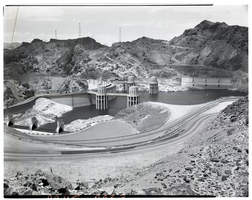
Film transparency of Hoover (Boulder) Dam, taken from the upstream side of the dam on the Arizona side, May, 1947
Date
1947-05
Archival Collection
Description
Hoover (Boulder) Dam, taken from the upstream side of the dam on the Arizona side, May, 1947. The intake towers, Nevada spillway house (in the background, behind the intake towers), and the Nevada spillway are visible. During the years of lobbying leading up to the passage of legislation authorizing the dam in 1928, Hoover Dam was originally referred to "Boulder Dam" or as "Boulder Canyon Dam", even though the proposed site had shifted to Black Canyon. The Boulder Canyon Project Act of 1928 (BCPA) never mentions a proposed name or title for the dam. When Secretary Wilbur spoke at the ceremony starting the building of the railway between Las Vegas and the dam site on September 17, 1930, he named the dam "Hoover Dam", citing a tradition of naming dams after Presidents, though none had been so honored during their terms of office. After Hoover's election defeat in 1932 and the accession of the Roosevelt administration, Secretary Ickes ordered on May 13, 1933 that the dam be referred to as "Boulder Dam". In the following years, the name "Boulder Dam" failed to fully take hold, with many Americans using both names interchangeably and map makers divided as to which name should be printed. In 1947, a bill passed both Houses of Congress unanimously restoring the name to "Hoover Dam".
Image
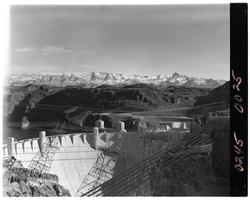
Film transparency of the face of Hoover (Boulder) Dam, taken from the downstream side of the dam on the Nevada side, May, 1947
Date
1947-05
Archival Collection
Description
Hoover (Boulder) Dam, taken from the downstream side of the dam on the Nevada side, May, 1947. The intake towers, several electric line towers, and the Arizona spillway are visible. During the years of lobbying leading up to the passage of legislation authorizing the dam in 1928, Hoover Dam was originally referred to "Boulder Dam" or as "Boulder Canyon Dam", even though the proposed site had shifted to Black Canyon. The Boulder Canyon Project Act of 1928 (BCPA) never mentions a proposed name or title for the dam. When Secretary Wilbur spoke at the ceremony starting the building of the railway between Las Vegas and the dam site on September 17, 1930, he named the dam "Hoover Dam", citing a tradition of naming dams after Presidents, though none had been so honored during their terms of office. After Hoover's election defeat in 1932 and the accession of the Roosevelt administration, Secretary Ickes ordered on May 13, 1933 that the dam be referred to as "Boulder Dam". In the following years, the name "Boulder Dam" failed to fully take hold, with many Americans using both names interchangeably and map makers divided as to which name should be printed. In 1947, a bill passed both Houses of Congress unanimously restoring the name to "Hoover Dam".
Image
Jon Ralston interview's Bill Boyd on "Face to Face": video
Date
2004-02-11
Archival Collection
Description
Jon Ralston's "Face to Face" interview segment with Bill Boyd on the upcoming merger of Coast Casinos and Boyd Gaming. Ralston sits with Bill Boyd to discuss the merger and the future of some more trouble casino properties. Boyd answers questions about the merger and how it will stand up to Station Casinos and other local casinos. He discusses acquiring additional properties in the mid-west and the southern part of the Las Vegas valley. He discusses the local population's changing view of gaming, and the future of building local casinos. Boyd answers questions about company revenue issues, and whether or not it affected the decision for the merger. He shares his view on megaresorts and the development of the Las Vegas Strip properties, and potential changes to the Stardust, and the redevelopment of the downtown area. Original media VHS, color, aspect ratio 4 x 3, frame size 720 x 486. From the Stardust Resort and Casino Records (MS-00515) -- Photographs and audiovisual material -- Digitized audiovisual material file.
Moving Image
"New and Improved" Stardust Resort and Casino renovation promotion [Spanish version]: video
Date
1997
Archival Collection
Description
Promotional video for the new and improved Stardust Resort and Casino which highlights new and improved amenities. The video focuses on the expanded check-in area, king sized rooms in the tower, renovated villa rooms, and a conference center with dedicated registration area and ballroom area, technologically advanced sound and lighting. The resort also offers many dining options, including the recent addition of Tres Lobos Restaurant, and enlargment of William B's, Tony Roma's, Ralph's Diner, Tucan Harry's 24-hour dining room, and the Warehouse Buffet. Recreation and entertainment options include two pools, spas, and poolside cocktail lounges. 24-hour gaming and "Enter the Night" offer many ways for guests to relax and unwind. This video is entirely in Spanish, but the same video as MS_00515_109. Original media VHS, color, aspect ratio 4 x 3, frame size 720 x 486. From the Stardust Resort and Casino Records (MS-00515) -- Photographs and audiovisual material -- Digitized audiovisual material file.
Moving Image
"Backstage Live" No. 289, featuring two Stardust employee talent contest winners: video
Date
2001-08-25
Archival Collection
Description
Las Vegas' only nationally live broadcast radio and television entertainment program, "Backstage Live with Gary Campbell and Connie Ross", was a free lounge show in the Grand Salon of the Imperial Palace Antique and Classic Auto Collections. Includes 2nd place winner from the Stardust talent show Ella Weaver who sings a song, Randy Young who sings a song and plays guitar, and Marianne Lorenz (Executive Director of the Las Vegas Art Museum) discusses the upcoming LVAM events. Second episode includes guests Ted Cash, Marianne Lorenz (Executive Director of the Las Vegas Art Museum), and 1st place singer in the Stardust Lorlene Coralisco (?) perform and discuss the event. Associate Producers for the show: Sheila Wallitsch, Colleen LoTempio, and Sandy Hackett. Original media VHS, color, aspect ratio 4 x 3, frame size 720 x 486. From the Stardust Resort and Casino Records (MS-00515) -- Photographs and audiovisual material -- Digitized audiovisual material file.
Moving Image
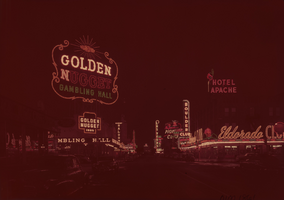
Film transparency of a nighttime view of Glitter Gulch on Fremont Street (Las Vegas), circa 1948
Date
1946 to 1950
Archival Collection
Description
Fremont Street at night circa 1948. This area of Fremont Street was also known as the Glitter Gulch.
Site Name: Fremont Street
Address: Fremont street, Las Vegas, NV
Image
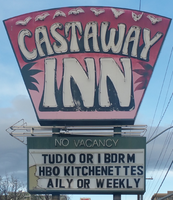
Castaway Inn double mounted pylon and marquee sign,
Date
2012 (year approximate) to 2018 (year approximate)
Archival Collection
Description
View of the sign for the Castaway Inn during the day with unlit neon.
525 W 2nd St, Reno, NV 89503
Image
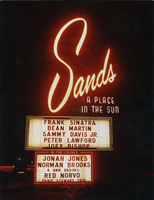
Color panel showing Sands Hotel marquee advertising the Rat Pack, Las Vegas, early 1960s
Date
1960 (year uncertain) to 1963 (year uncertain)
Archival Collection
Description
Sands Hotel and Casino marquee night shot. Marquee headline reads, "Frank Sinatra, Dean Martin, Sammy Davis, Jr., Peter Lawford, Joey Bishop." Scanned from color panel (print) of 0287 0116.
Image
Pagination
Refine my results
Content Type
Creator or Contributor
Subject
Archival Collection
Digital Project
Resource Type
Year
Material Type
Place
Language
Records Classification
